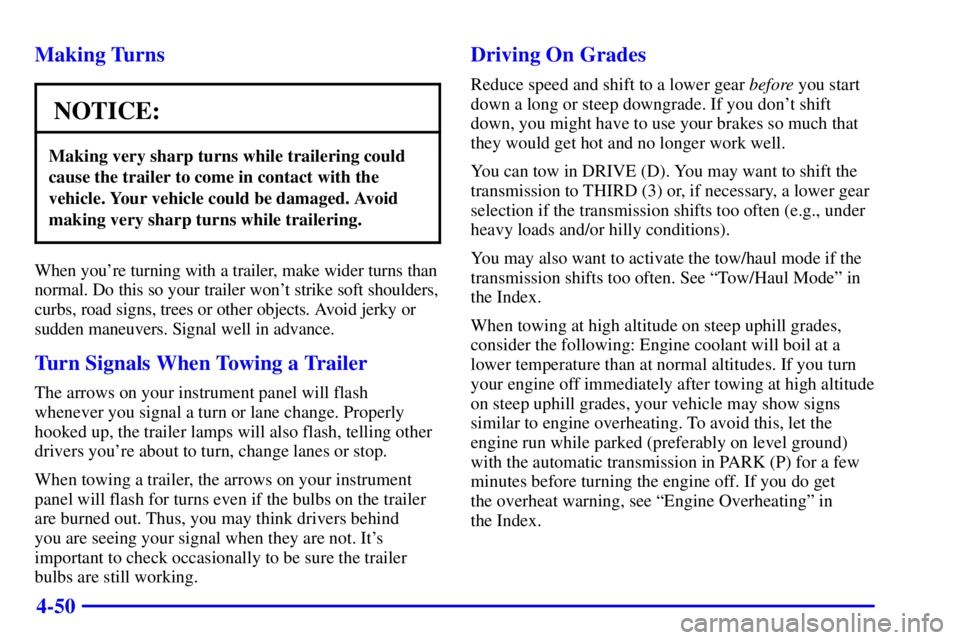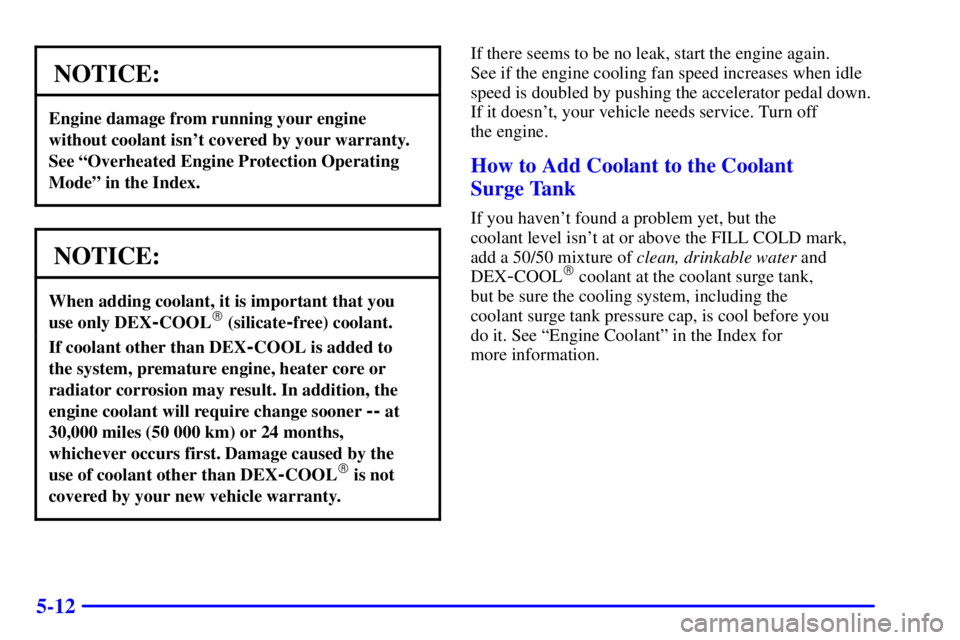Page 167 of 394
2-80 Low Coolant
This message is displayed
when the cooling system is
low on coolant.
The engine may overheat. See ªEngine Coolantº in the
Index and have your vehicle serviced as soon as you can.
Check Coolant Temp
This message is displayed
when the cooling system
temperature gets hot.
Check the coolant temperature gage and the coolant
level. See ªEngine Coolant,º ªEngine Coolant
Temperature Gageº and ªEngine Overheatingº in the
Index for further information.
Engine Overheated
This message is displayed
when the cooling system
temperature gets too hot.
This message will be displayed after the air conditioning
system has automatically turned off for the engine
coolant protection mode. See ªEngine Overheatingº in
the Index for further information.
Reduced Engine Power
This message is displayed
when the cooling system
temperature gets too hot
and the engine further
enters the engine coolant
protection mode.
See ªEngine Overheatingº in the Index for
further information.
Page 178 of 394

3-3
Mode Knob - Automatic Operation
The right knob on the control panel allows you to
choose the direction of air delivery. When the system
is set in AUTO mode, sensors will control the air
delivery mode. Air will come primarily from the floor
or instrument panel outlets, with some air directed to
the windshield to prevent fogging.
When the system is in AUTO mode, the air conditioning
light will turn on, and the recirculation and outside air
lights turn off. With the system in full auto control
(both the fan and mode knobs in AUTO), you still
have the ability to override any function. However,
continually overriding the outside air or the A/C
compressor will limit the ability of the system to
cool the vehicle quickly.
If you push a button for a function which is not
available, the light next to that button will flash
three times to alert you that it's not available.
To find your comfort zone, start with the 74�F (23�C)
setting and allow about 20 minutes for the system to
adjust the temperature if necessary.With the automatic setting, the air conditioning
compressor automatically cycles when needed to cool
the air. In cold weather, when the system senses the need
for heat, the airflow will be directed out of the floor
outlets. As the interior temperature approaches a desired
setting, the fan speed will decrease. To maintain interior
comfort, the airflow will adjust between the instrument
panel air outlets and floor outlets. On bright sunny days
in cool weather, the airflow may come out of the air
conditioning and floor outlets (bi
-level mode) to
maintain comfort and prevent stuffiness.
To avoid blowing cold air in cold weather, the system
will delay turning on the fan until warm air is available.
The length of delay depends on the outside air
temperature, engine coolant temperature or the time
since the engine was last started. As the coolant warms
up, the fan speed will gradually increase and air will
flow from the heater outlets, with some airflow to
the windshield to prevent fogging under most
normal conditions.
Be careful not to put anything over the solar sensor
located around the center of the instrument panel.
This sensor is used by the automatic system to
regulate temperature.
Page 251 of 394

4-50 Making Turns
NOTICE:
Making very sharp turns while trailering could
cause the trailer to come in contact with the
vehicle. Your vehicle could be damaged. Avoid
making very sharp turns while trailering.
When you're turning with a trailer, make wider turns than
normal. Do this so your trailer won't strike soft shoulders,
curbs, road signs, trees or other objects. Avoid jerky or
sudden maneuvers. Signal well in advance.
Turn Signals When Towing a Trailer
The arrows on your instrument panel will flash
whenever you signal a turn or lane change. Properly
hooked up, the trailer lamps will also flash, telling other
drivers you're about to turn, change lanes or stop.
When towing a trailer, the arrows on your instrument
panel will flash for turns even if the bulbs on the trailer
are burned out. Thus, you may think drivers behind
you are seeing your signal when they are not. It's
important to check occasionally to be sure the trailer
bulbs are still working.
Driving On Grades
Reduce speed and shift to a lower gear before you start
down a long or steep downgrade. If you don't shift
down, you might have to use your brakes so much that
they would get hot and no longer work well.
You can tow in DRIVE (D). You may want to shift the
transmission to THIRD (3) or, if necessary, a lower gear
selection if the transmission shifts too often (e.g., under
heavy loads and/or hilly conditions).
You may also want to activate the tow/haul mode if the
transmission shifts too often. See ªTow/Haul Modeº in
the Index.
When towing at high altitude on steep uphill grades,
consider the following: Engine coolant will boil at a
lower temperature than at normal altitudes. If you turn
your engine off immediately after towing at high altitude
on steep uphill grades, your vehicle may show signs
similar to engine overheating. To avoid this, let the
engine run while parked (preferably on level ground)
with the automatic transmission in PARK (P) for a few
minutes before turning the engine off. If you do get
the overheat warning, see ªEngine Overheatingº in
the Index.
Page 265 of 394
5-11
Cooling System
When you decide it's safe to lift the hood, here's what
you'll see:
A. Coolant Surge Tank
B. Coolant Surge Tank Pressure Cap
C. Engine Fan
If the coolant inside the coolant surge tank is boiling,
don't do anything else until it cools down.
When the engine is
cold, the coolant level
should be at or above
the FILL COLD mark.
If it isn't, you may
have a leak in the
radiator hoses,
heater hoses, radiator,
water pump or
somewhere else in
the cooling system.
CAUTION:
Heater and radiator hoses, and other engine
parts, can be very hot. Don't touch them. If you
do, you can be burned.
Don't run the engine if there is a leak. If you run
the engine, it could lose all coolant. That could
cause an engine fire, and you could be burned.
Get any leak fixed before you drive the vehicle.
Page 266 of 394

5-12
NOTICE:
Engine damage from running your engine
without coolant isn't covered by your warranty.
See ªOverheated Engine Protection Operating
Modeº in the Index.
NOTICE:
When adding coolant, it is important that you
use only DEX
-COOL� (silicate-free) coolant.
If coolant other than DEX-COOL is added to
the system, premature engine, heater core or
radiator corrosion may result. In addition, the
engine coolant will require change sooner
-- at
30,000 miles (50 000 km) or 24 months,
whichever occurs first. Damage caused by the
use of coolant other than DEX
-COOL� is not
covered by your new vehicle warranty.
If there seems to be no leak, start the engine again.
See if the engine cooling fan speed increases when idle
speed is doubled by pushing the accelerator pedal down.
If it doesn't, your vehicle needs service. Turn off
the engine.
How to Add Coolant to the Coolant
Surge Tank
If you haven't found a problem yet, but the
coolant level isn't at or above the FILL COLD mark,
add a 50/50 mixture of clean, drinkable water and
DEX
-COOL� coolant at the coolant surge tank,
but be sure the cooling system, including the
coolant surge tank pressure cap, is cool before you
do it. See ªEngine Coolantº in the Index for
more information.
Page 270 of 394
5-16
4. With the coolant surge tank pressure cap off, start the
engine and let it run until you can feel the upper
radiator hose getting hot. Watch out for the engine
cooling fan.
By this time, the coolant level inside the coolant
surge tank may be lower. If the level is lower, add
more of the proper mixture to the coolant surge tank
until the level reaches FILL COLD mark.5. Then replace the pressure cap. Be sure the pressure
cap is hand
-tight.
Page 289 of 394

6-
6-1
Section 6 Service and Appearance Care
Here you will find information about the care of your vehicle. This section begins with service and fuel information,
and then it shows how to check important fluid and lubricant levels. There is also technical information about your
vehicle, and a part devoted to its appearance care.
6
-2 Service
6
-3 Fuel
6
-5 Fuels in Foreign Countries
6
-5 Filling Your Tank
6
-7 Filling a Portable Fuel Container
6
-8 Checking Things Under the Hood
6
-10 Engine Oil
6
-15 Engine Air Cleaner/Filter
6
-17 Passenger Compartment Air Filter
6
-17 Automatic Transmission Fluid
6
-21 Rear Axle
6
-21 All-Wheel Drive
6
-24 Engine Coolant
6
-27 Coolant Surge Tank Pressure Cap
6
-28 Power Steering Fluid6
-29 Windshield Washer Fluid
6
-30 Brakes
6
-34 Battery
6
-35 Bulb Replacement
6
-39 Windshield Wiper Blade Replacement
6
-40 Tires
6
-48 Appearance Care
6
-49 Cleaning the Inside of Your Vehicle
6
-52 Cleaning the Outside of Your Vehicle
6
-56 GM Vehicle Care/Appearance Materials
6
-57 Vehicle Identification Number (VIN)
6
-58 Electrical System
6
-66 Replacement Bulbs
6
-66 Capacities and Specifications
6
-67 Normal Maintenance Replacement Parts
Page 314 of 394
6-26 Checking Coolant
The coolant surge tank is
located in the engine
compartment on the
passenger's side of
the vehicle.
See ªEngine Compartment Overviewº in the Index for
more information on location.CAUTION:
Turning the surge tank pressure cap when the
engine and radiator are hot can allow steam and
scalding liquids to blow out and burn you badly.
Never turn the surge tank pressure cap
-- even a
little
-- when the engine and radiator are hot.
The vehicle must be on a level surface. When your
engine is cold, the coolant level should be at the
FILL COLD mark.
If the LOW COOLANT
message comes on and
stays on, it means you're
low on engine coolant.
See ªLow Coolantº in the Index.